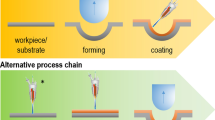Abstract—Metal additive manufacturing is widely studied for its unique advantages over traditional manufacturing processes. It is used to form complex components of Ti, Fe, or Ni alloys. However, for nonferrous alloys—aluminum, magnesium, copper—additive technologies are not used because of rapid melting during laser, electron beam, and/or arc treatment. Cold spraying is widely used as an effective technology for applying high quality coatings in the mass production of metal and alloy products and/or metal matrix composite coatings. In addition, cold spraying is a serious and effective tool for the additive manufacturing of metals, and research in this area is currently becoming intense. It is shown in the work that the use of cold spraying technology makes it possible to obtain composite materials based on aluminum and titanium reinforced with boron carbide. Zirconium dioxide chosen as the reinforcing component could not be introduced into the composite based on aluminum and nickel, which is most likely due to the large particle size. During thermal treatment of materials obtained by cold spraying, new chemical compounds are formed—both intermetallic compounds and hardening ceramic inclusions that increase the microhardness. At the same time, the microhardness increases by about 7 times, but the linear dimensions decrease, which is not observed in the system based on nickel aluminide. However, as a result of a change in the structure during chemical transformations, a change in the geometry of the product and the formation of pores can be observed.











Similar content being viewed by others
Notes
Hereinafter, mass content of elements (wt %) is presented.
REFERENCES
Gibson, D. and Rosen, B.S., Additive Manufacturing Technologies, New York: Springer, 2010.
Gu, D.D. et al., Laser additive manufacturing of metallic components: Materials, processes and mechanisms, Int. Mater. Rev., 2012, vol. 57, no. 3, pp. 133–164.
Murr, L.E., Frontiers of 3D printing/additive manufacturing: from human organs to aircraft fabrication, J. Mater. Sci. Technol., 2016, vol. 32, no. 10, pp. 987–995.
Assadi, H. et al., Cold spraying – a materials perspective, Acta Mater., 2016, vol. 116, pp. 382–407.
Papyrin, A., Cold spray technology, Adv. Mater. Process., 2001, vol. 159, pp. 49–51.
Arabgol, Z. et al., Analysis of thermal history and residual stress in cold-sprayed coatings, J. Therm. Spray Technol., 2014, vol. 23, no. 1, pp. 84–90.
Li, W. et al., Solid-state additive manufacturing and repairing by cold spraying: A review, J. Mater. Sci. Technol., 2018, vol. 34, no. 3, pp. 440–457.
Ziemian, C.W., Wright, W.J., and Cipoletti, D.E., Influence of impact conditions on feedstock deposition behavior of cold-sprayed Fe-based metallic glass, J. Therm. Spray Technol., 2018, vol. 27, no. 5, pp. 843–856.
Karmakar, R., Maji, P., and Ghosh, S.K., A review on the nickel based metal matrix composite coating, Met. Mater. Int., 2021, vol. 27, pp. 2134–2145. https://doi.org/10.1007/s12540-020-00872-w
Champagne, V. and Helfritch, D., The unique abilities of cold spray deposition, Int. Mater. Rev., 2016, vol. 61, no. 7, pp. 437–455.
Suhonen, T. et al., Residual stress development in cold sprayed Al, Cu and Ti coatings, Acta Mater., 2013, vol. 61, pp. 6329–6337.
Coddet, P. et al., Comparison of the properties of cold-sprayed Cu–0.5Cr–0.05Zr alloys after various heat treatments versus forged and vacuum plasma-sprayed alloys, J. Therm. Spray Technol., 2014, vol. 23, no. 3, pp. 486–491.
Coddet, P. et al., Mechanical properties of Cu–0.1Ag alloys deposited by cold spray with various powder feed rate and heat treatment, J. Therm. Spray Technol., 2015, vol. 24, no. 1, pp. 119–125.
Pogrebnjak, A.D. et al., The structure and properties of high-entropy alloys and nitride coatings based on them, Russ. Chem. Rev., 2014, vol. 83, no. 11, pp. 1027–1061.
Bagherifard, S., Roscioli, G., Zuccoli, M.V., Hadi, M., D’Elia, G., Demir, A.G., Previtali, B., Kondás, J., and Guagliano, M., Cold spray deposition of freestanding inconel samples and comparative analysis with selective laser melting, J. Therm. Spray Technol., 2017, vol. 26, pp. 1517–1526.
Gerashchenkov, D.A., Vasiliev A.F., Farmakovsky, B.V., and Mashek, A.Ch., Study of the flow temperature in the cold gas-dynamic spraying of the functional coatings, Vopr. Materialoved., 2014, no. 1 (77), pp. 87–96. https://elibrary.ru/item.asp?id=21515704
Zhao, H. and Bing, C., Formation of TiB2–TiC composites by reactive sintering, Ceram. Int., 1999, vol. 25, pp. 353–358.
Pan, C., Zhang, J., and Zhu, B., Structure formation and densification of TiB2–TiC–Ni composites produced by chemical reaction of Ti–B4C system in high-gravity field, IOP Conf. Ser.: Mater. Sci. Eng., 2018, vol. 382, no. 2, art. ID 22049.
Funding
This work was carried out within the framework of the Russian Science Foundation (RSF), project no. 21-73-30019.
Author information
Authors and Affiliations
Corresponding author
Additional information
Translated by K. Gumerov
Rights and permissions
About this article
Cite this article
Gerashchenkov, D.A. Application of Cold Gas Dynamic Spraying as an Additive Technology for Producing Materials Based on Nickel Aluminide and Titanium Aluminide. Inorg. Mater. Appl. Res. 13, 1575–1581 (2022). https://doi.org/10.1134/S2075113322060077
Received:
Revised:
Accepted:
Published:
Issue Date:
DOI: https://doi.org/10.1134/S2075113322060077




